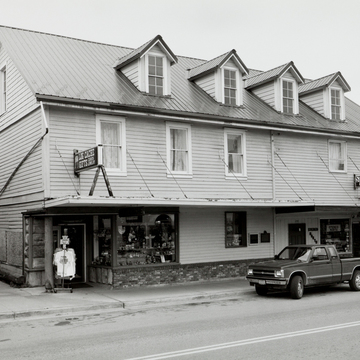One of the few Russian-era buildings in Alaska is hidden behind clapboarding, altered fenestration, and additions. Designated Building No. 29 on the map that accompanied the transfer of Alaska to the United States, this structure was built by the Russian-American Company, probably in the 1850s.
The two-story log structure was originally three bays wide, with a gable roof. The logs were grooved on the bottoms to fit over the ones below; they were also marked with both Roman and Arabic numerals and dovetailed at the corners. Shortly after construction, a two-story, shed-roofed gallery was added to the west end, functioning as an entrance, stairway, and air lock, as at the Russian Bishop's House. In the 1880s another two-bay addition was constructed at the west end, incorporating the gallery under its gable roof. Four gable dormers were added to what had become a six-bay structure. In the 1960s, a storefront window and entrance at the northeast corner were introduced, eliminating one of the original window openings.
In 1867, the Russian-American Company sold this building to William Dodge, acting customs collector and first mayor of Sitka. Through the years, the building has passed through several hands and has been primarily used as commercial retail space on the ground floor and as a residence above. During a recent renovation, a layer of sand suspended in canvas nailed to the ceiling was removed. Large brick bake ovens are still in the basement.
Although the origins of this building are not readily apparent, Building No. 29 is a rare survivor of the Russian-American Company's governance of Alaska. It has been designated a National Historic Landmark.

